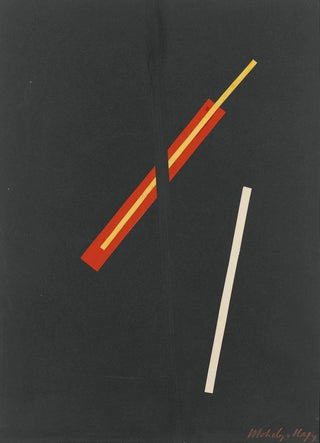Art print | Collage with three elements (Conflict of cases) - László Moholy-Nagy


View from behind

Frame (optional)
Collage with three elements (Case Conflict): an exploration of visual tensions
"Collage with three elements (Case Conflict)" by László Moholy-Nagy is an intriguing art print that evokes tensions and harmonies through its shapes and colors. This complex composition plays on contrasts, where the elements seem to both confront and unite each other. The collage techniques used by Moholy-Nagy allow for layering textures and patterns, creating a visual depth that captures attention. The overall atmosphere of the artwork is both dynamic and contemplative, inviting the viewer to immerse themselves in a world where every detail matters and each element tells a story.
László Moholy-Nagy: a visionary of design and art
László Moholy-Nagy, born in 1895, was a Hungarian artist and designer who played a key role in the development of the Bauhaus. His interdisciplinary approach, blending photography, painting, and graphic design, profoundly influenced modern art. Moholy-Nagy believed in the importance of experimentation and innovation, seeking to integrate art into everyday life. "Collage with three elements (Case Conflict)" perfectly illustrates this philosophy, using modern techniques to create an artwork that transcends traditional boundaries of art. His legacy endures today, inspiring many contemporary artists.
A decorative acquisition with multiple assets
The reproduction of "Collage with three elements (Case Conflict)" is a decorative choice that enriches any space, whether it is a modern office, an artistic living room, or an inspiring bedroom. Its print quality ensures remarkable fidelity to the original artwork, allowing you to fully enjoy the richness of details and colors. This canvas, through its aesthetic appeal, becomes a focal point in your interior decoration, sparking curiosity and admiration. By incorporating this reproduction into your space, you add a touch of elegance and modernity, while celebrating the legacy of a master of modern art.

Matte finish

View from behind

Frame (optional)
Collage with three elements (Case Conflict): an exploration of visual tensions
"Collage with three elements (Case Conflict)" by László Moholy-Nagy is an intriguing art print that evokes tensions and harmonies through its shapes and colors. This complex composition plays on contrasts, where the elements seem to both confront and unite each other. The collage techniques used by Moholy-Nagy allow for layering textures and patterns, creating a visual depth that captures attention. The overall atmosphere of the artwork is both dynamic and contemplative, inviting the viewer to immerse themselves in a world where every detail matters and each element tells a story.
László Moholy-Nagy: a visionary of design and art
László Moholy-Nagy, born in 1895, was a Hungarian artist and designer who played a key role in the development of the Bauhaus. His interdisciplinary approach, blending photography, painting, and graphic design, profoundly influenced modern art. Moholy-Nagy believed in the importance of experimentation and innovation, seeking to integrate art into everyday life. "Collage with three elements (Case Conflict)" perfectly illustrates this philosophy, using modern techniques to create an artwork that transcends traditional boundaries of art. His legacy endures today, inspiring many contemporary artists.
A decorative acquisition with multiple assets
The reproduction of "Collage with three elements (Case Conflict)" is a decorative choice that enriches any space, whether it is a modern office, an artistic living room, or an inspiring bedroom. Its print quality ensures remarkable fidelity to the original artwork, allowing you to fully enjoy the richness of details and colors. This canvas, through its aesthetic appeal, becomes a focal point in your interior decoration, sparking curiosity and admiration. By incorporating this reproduction into your space, you add a touch of elegance and modernity, while celebrating the legacy of a master of modern art.






